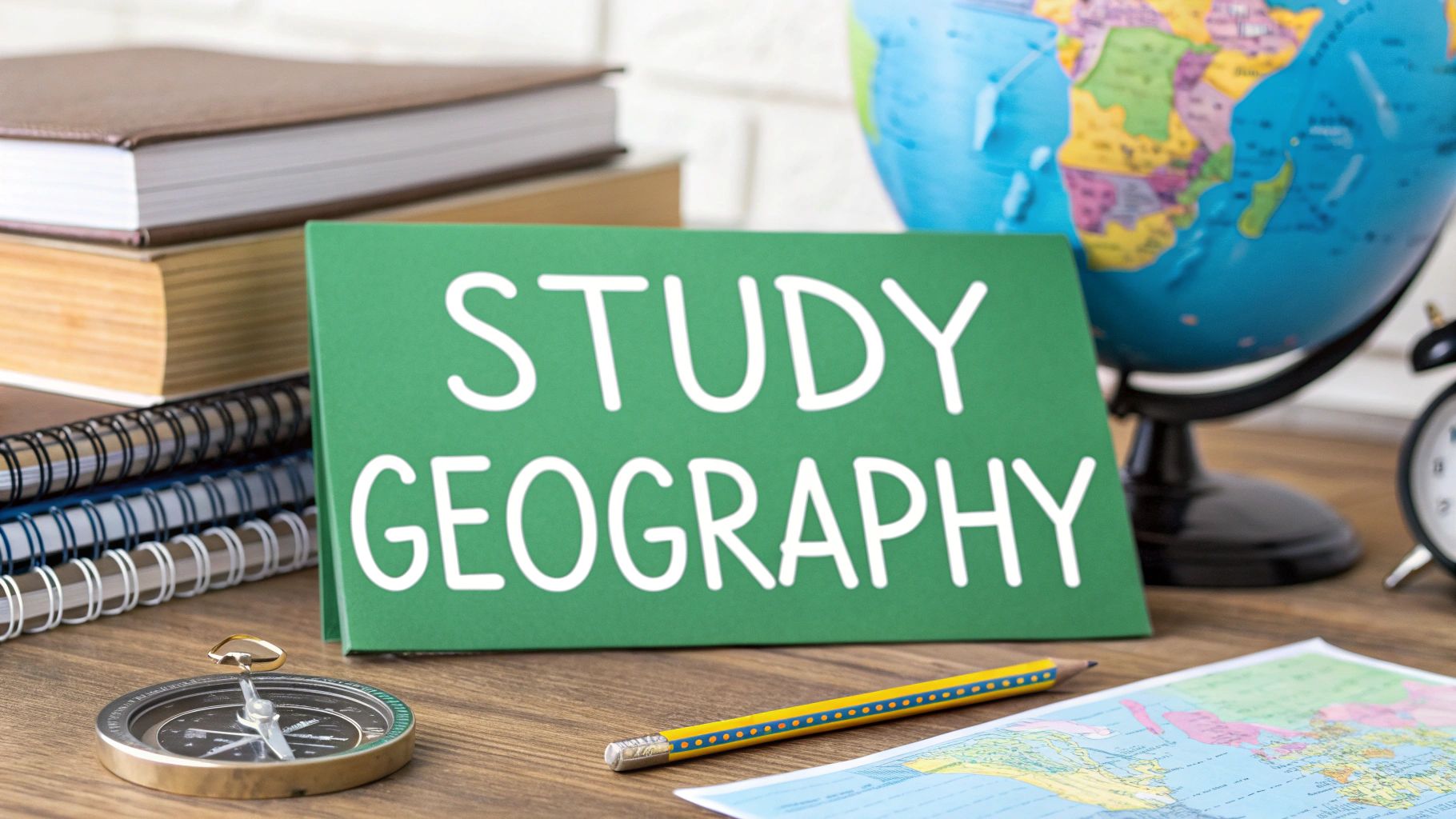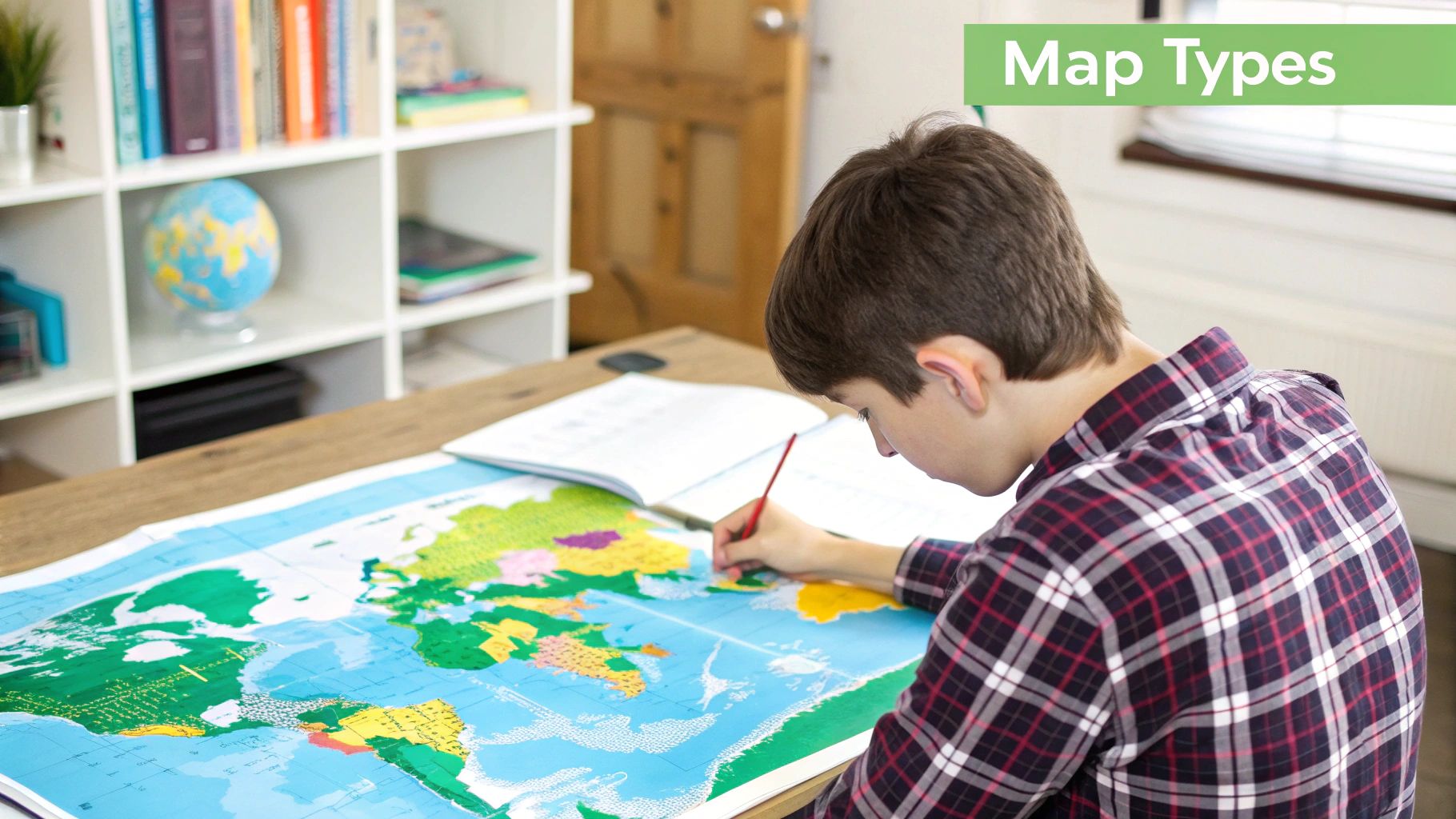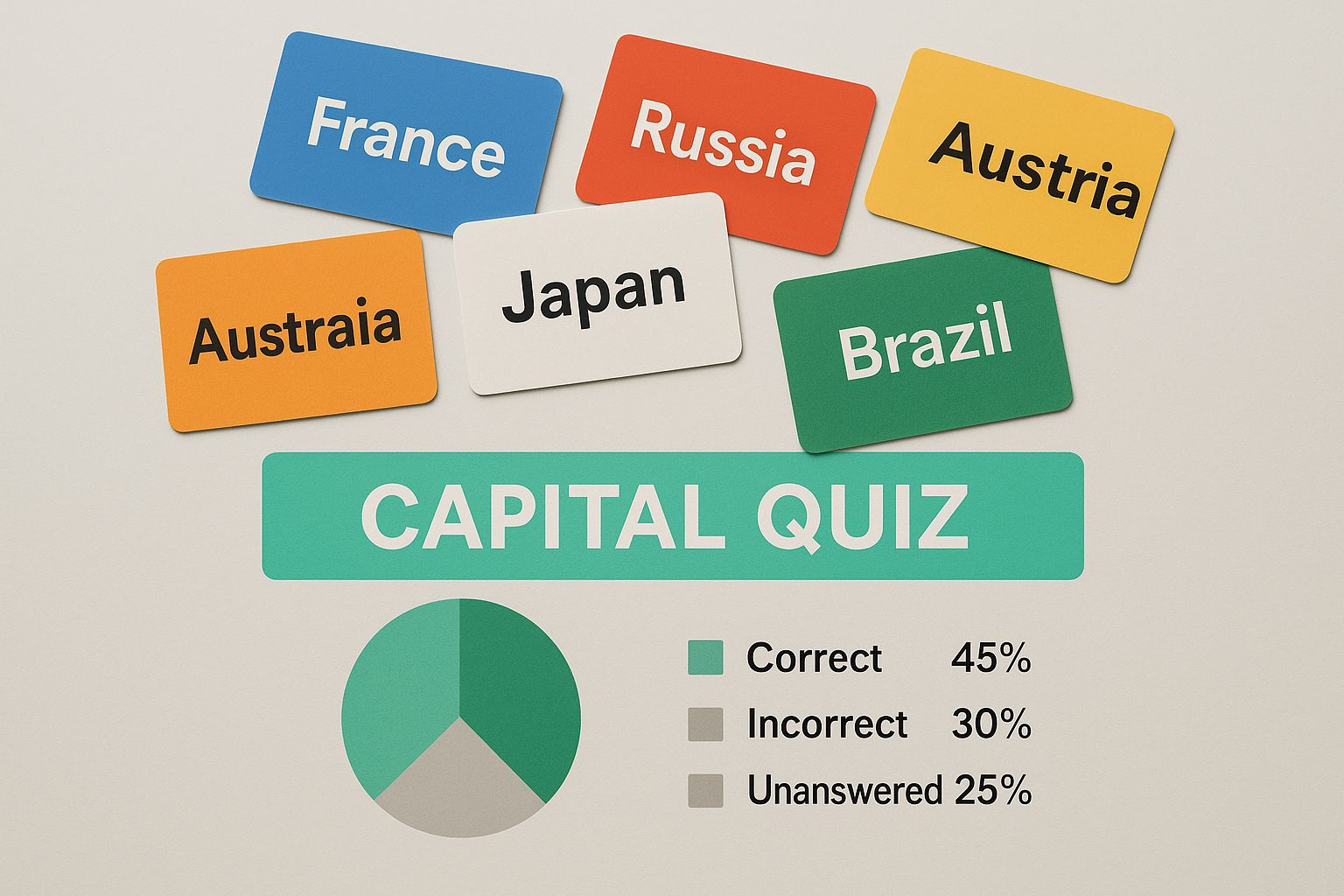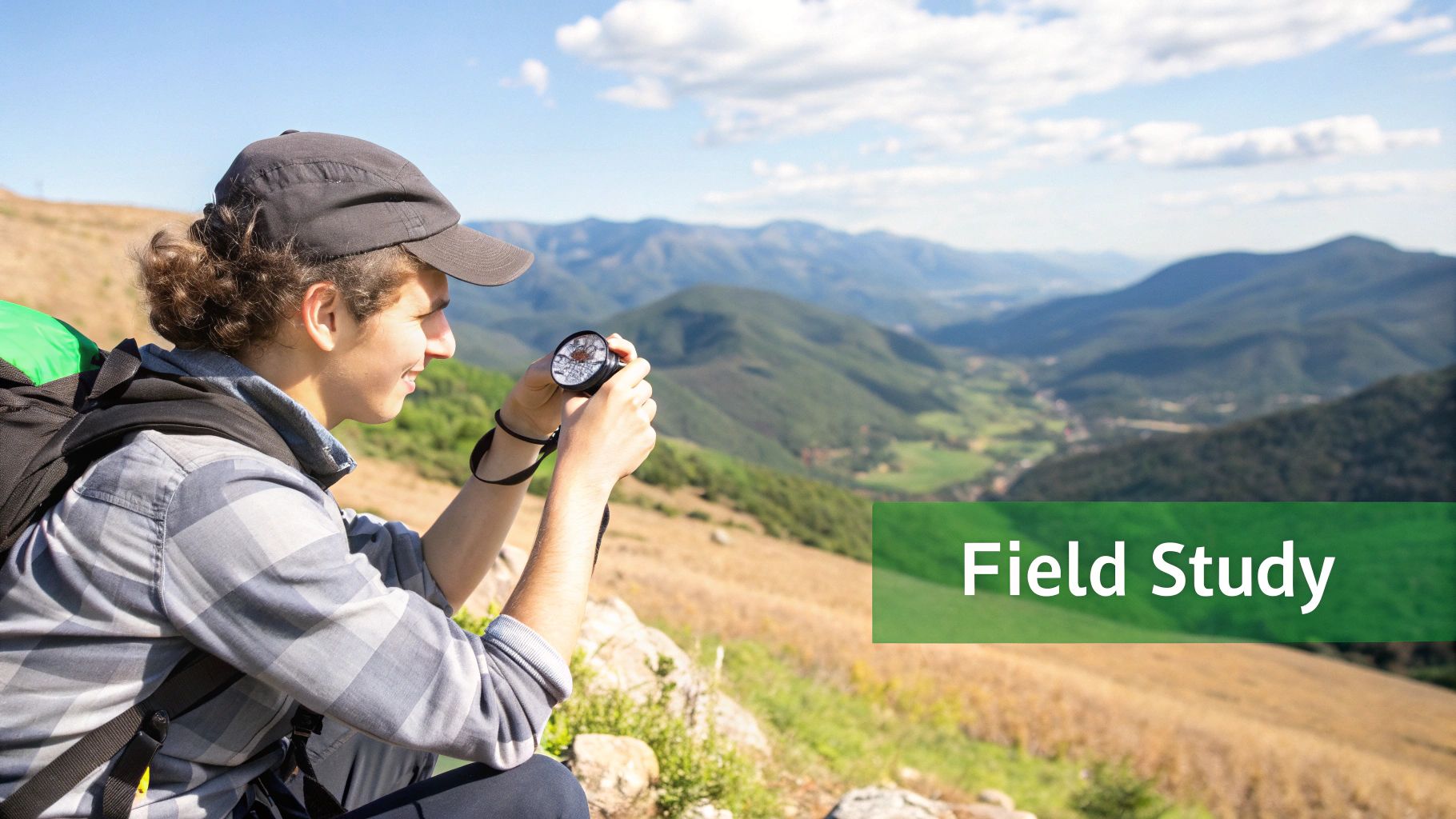How to Study Geography Like an Expert
Discover how to study geography with proven strategies. Learn to think spatially, leverage technology, and master core concepts with this practical guide.

Forget what you remember from school—geography isn't about memorizing dusty maps and random capitals anymore. It's about developing a spatial thinker's mindset, learning to see the intricate connections between people, places, and the environment.
This means you stop just looking at a map and start asking why things are the way they are. You begin to see the world as a massive, interconnected system.
Why Geography Is More Than Just Maps
Today, understanding geography is the key to unpacking some of the biggest challenges we face as a global community. It's how you make sense of everything from tangled international supply chains and sprawling urban growth to the real-world impacts of climate change.
This field has exploded far beyond simply knowing place names. Geographers are now on the front lines, using their skills to solve complex problems every single day.
- Urban Planning: They're the ones analyzing population density to design cities that are actually livable and sustainable.
- Public Health: Geographers map out disease outbreaks, figuring out how they spread and identifying who is most vulnerable.
- International Relations: They dig into how physical borders, the distribution of natural resources, and cultural landscapes shape everything from political conflicts to global alliances.
A Modern Lens on a Connected World
When you look at it this way, geography shifts from a static school subject to a dynamic lens for understanding the world around you. The question isn't just "what is where," but why it's there and what that means for all of us.
For example, understanding the physical geography of a river valley does more than tell you where a river is. It explains historical settlement patterns, why certain crops are grown there today, and what the flood risks look like for the future.
This applied approach is absolutely critical. Yet, getting people to this level of understanding is a huge challenge. In the U.S., a partnership between the National Geographic Society and Esri set a pretty ambitious goal: get 80% of students to a baseline of geographic literacy by 2025. They're also shooting for a 50% geographic fluency rate, which means students can actually apply these skills to succeed in careers like environmental science or international affairs. You can read more about these educational goals here.
The real power of geography is its ability to connect the dots. It helps you see how a decision made in one part of the world—like a new trade policy—can send ripple effects thousands of miles away.
Ultimately, learning how to study geography is really about building a framework for critical thinking. It gives you the tools to analyze information spatially, question your own assumptions, and appreciate the complex web of relationships that shape our planet. In a world as connected as ours, that perspective is more valuable than ever.
Mastering the Five Themes of Geography

To really get good at geography, you need a mental framework to hang all the facts on. This is where the five themes of geography come in. Don't think of them as dry definitions to memorize for a test. Instead, see them as five different lenses you can use to look at any spot on Earth and understand what makes it tick.
This framework gives you a structure for asking the right questions and seeing the deeper connections that truly define a place. It's the foundation for everything else you'll learn.
As we dive in, it’s worth remembering that the ability to study is a privilege. In 2023, UNESCO reported that an astonishing 272 million children and youth were out of school, a number that had jumped by 21 million. This global reality shapes how subjects like geography are even accessed, let alone mastered. You can dig deeper into these numbers over at the World Education Blog.
Location and Place
First up, let’s tackle Location and Place. They sound almost the same, but they answer completely different questions.
Location is the "where." It’s a precise point on the map, defined by absolute coordinates like latitude and longitude. Think of it as a street address for the planet.
Place, on the other hand, is all about the unique character of that spot. It answers, "What's it like there?" This includes its physical side (mountains, rivers, climate) and its human side (culture, language, architecture). A Parisian café has a specific location, but its place is a whole experience—the smell of espresso, the sound of French chatter, and the energy of the city.
Human-Environment Interaction
This theme is all about the constant give-and-take between people and their surroundings. It explores how we adapt to, modify, and depend on the environment we live in.
Just think of the massive Hoover Dam. That's a textbook example of humans modifying the environment to generate power and manage water in a desert. On the flip side, people in hurricane-prone coastal areas adapt by building their homes up on stilts.
Understanding this dynamic is crucial for getting a handle on big global issues like resource depletion, pollution, and climate change. It’s the story of our ongoing dance with the planet.
Movement and Regions
Finally, we have Movement and Regions. Movement isn't just about people packing up and migrating. It's the flow of goods, ideas, and information zipping across the globe every single second.
Take your smartphone. The raw materials might be mined in Africa, assembled in Asia using tech designed in North America, and then shipped to your door. That entire, complex journey is Movement in action.
Regions are simply areas grouped together because they share something in common. Geographers usually break them down into three types:
- Formal: These are defined by official boundaries, like countries, states, or cities. They're clear-cut.
- Functional: These are organized around a central hub or node, like a big city and its surrounding suburbs all connected by commuter trains and highways.
- Vernacular: These are the regions defined by people's perceptions—think "the Midwest" or "Silicon Valley." They don't have official borders, but we all know what they mean.
By using these five themes, you stop just memorizing names and start thinking like a real geographer. If you're ready to take these ideas global, our guide on how to learn world geography has a ton of practical tips to get you started.
How to Develop a Spatial Thinker's Mindset
True geographic mastery isn't about just memorizing a list of capitals. It's about learning to see the world differently—developing a spatial thinker's mindset where you instinctively see the patterns, connections, and relationships between places.
It’s a fundamental shift. You go from simply knowing where something is to understanding why it’s there and how it links to everything else. This skill turns you from a passive observer into an active investigator of the world around you.
Thinking Spatially in Daily Life
You can start practicing this skill right now, without opening a book. Think about your daily commute. Don't just follow the rote path—analyze it. Why does that road curve just so? Are the businesses clustered near the highway exit for a reason? Is there a geographic logic to where the city decided to put a park?
This simple exercise trains your brain to look for spatial logic everywhere. Take it a step further. Trace the journey of a product you use every day, like your t-shirt. Imagine its global supply chain: from a cotton field to a textile mill, then a factory, a shipping container, and finally, to the store. Visualizing this movement builds a powerful mental map of global interconnectedness.
A spatial thinker doesn't just see a city on a map; they see a complex system of transportation networks, economic zones, and cultural neighborhoods all interacting with the physical landscape.
This evolution in thinking is mirrored in how education itself has spread across the globe. As geographer Dr. Matt Finn notes, nations with higher literacy often integrate technologies like geographic information systems (GIS) more effectively. This directly strengthens their students' spatial reasoning skills. You can explore more about the global evolution of education systems and its impact.
From Mental Maps to Digital Tools
Once you get comfortable with mental mapping, it's time to bring in some powerful tools. Free software like Google Earth Pro lets you break free from flat maps and explore the planet in stunning 3D. You can "fly" over the Himalayas to truly grasp their scale or zoom into a city to see its layout from a perspective you've never imagined.

While powerful digital tools are fantastic for exploration, don't discount hands-on methods. Tactile techniques like flashcards are excellent for building that foundational place-name knowledge you'll need.
Use these tools to ask—and answer—your own geographic questions. Here are a few ideas to get you started:
- Use the historical imagery feature to watch your town change over the last 20 years.
- Measure the distance between major global ports to understand the logic of shipping routes.
- Overlay data layers to see the relationship between elevation and population density.
When you actively engage with these tools, you're not just studying geography—you're doing it. You're building the muscle of spatial analysis, an invaluable skill for making sense of our complex and interconnected world.
Active Learning Strategies That Get Results
Embedded content
Let's be honest: passively rereading your textbook is one of the least effective ways to learn geography. To really get a handle on the complex systems that shape our planet, you need to roll up your sleeves and engage your brain.
This means shifting from just memorizing facts to actively analyzing them. Instead of just learning the definition of urban sprawl, you need to dig into what it looks like in the real world.
Dive Into Real-World Case Studies
Broad concepts click into place when you anchor them to a specific, tangible example. "Water management" is abstract. But when you start looking at the Colorado River Basin in the American West, it becomes very real. Suddenly you're grappling with competing states, genuine economic interests, and the hard consequences of policy decisions.
Another great example is the regeneration of London's Battersea Power Station. Don't just read about it. Pull up photos, census data, and articles. See how the project is viewed from different angles—by developers, by long-time residents, by the city. This is how you start to think like a geographer.
Case studies force you to ask the right questions: What caused this? Who is affected? What are the long-term impacts? It’s the very foundation of real geographic analysis.
Visualize Connections With Concept Maps
Geography is all about connections—how a mountain range shapes a culture, how a shipping lane drives an economy, or how weather patterns impact food supply. Concept maps are the perfect tool for laying out these intricate webs.
Put a central idea in the middle of a page, like "deforestation in the Amazon." Then, start branching out.
- Causes: Cattle ranching, soybean farming, illegal logging.
- Effects: Loss of biodiversity, soil erosion, impact on indigenous communities.
- Stakeholders: Local farmers, international corporations, governments, environmental groups.
This isn't just about organizing notes; it's about seeing the system as a whole. The process of building the map itself is often where the real learning happens, revealing connections you'd otherwise miss.
Tell the Geographic Story
Humans are wired for stories. It’s one of the best tricks I know for making complex geographic information stick. Instead of trying to memorize a dry list of facts about a country, tell its story.
Start with the physical landscape—the mountains that isolated its people, the rivers that became their highways, the coastlines that opened them to trade. Then, layer in the human element. How did people adapt? Where did cities pop up and why? This technique creates a mental framework that makes isolated facts much easier to recall because they're part of a bigger, more meaningful narrative.
You can supercharge this by using educational games for geography. A good game doesn't just quiz you; it turns learning into an interactive adventure, reinforcing these stories through hands-on exploration.
Using Technology and Fieldwork to Learn

To really get geography, you have to get your hands dirty—both digitally and literally. The fastest way to make concepts stick is to bridge the gap between what you read in a textbook and what you can see and touch in the real world.
This means you need to step away from the screen and into the world, but it also means using technology to explore places you might never get to visit.
This blend of digital deep-dives and old-school observation is where the magic happens. It flips learning from a passive chore into an active investigation. Suddenly, you're not just a student; you're a geographic detective.
Harnessing Digital Geography Tools
Modern tech has handed us an incredible sandbox for exploring geography. Virtual globes like Google Earth and online Geographic Information System (GIS) platforms let you peel back the layers of our world right from your desk. These aren’t just fancy maps—they are seriously powerful analytical tools.
For instance, you could use a GIS platform to overlay a map of a city’s income levels with its public transit routes. Right away, you’ll start seeing spatial patterns emerge, prompting deeper questions about access, equity, and urban planning. That's the core of thinking like a geographer.
Another fantastic approach is gamification. I’m a big fan of games like EarthChasers because they turn learning into a mission, challenging you to navigate real-world landscapes to solve problems. This method is built on the principles of interactive learning, which makes the whole process of discovery not just memorable, but genuinely fun.
Getting Your Boots on the Ground
As amazing as digital tools are, nothing can fully replace fieldwork. And don't worry, you don’t need to plan a massive expedition to the Amazon. You can conduct powerful mini-fieldwork sessions right in your own neighborhood.
This hands-on approach is what connects abstract ideas to the tangible world humming along right outside your door.
Fieldwork trains your eyes to see the geographic story written on the landscape. It’s about observing, questioning, and connecting what you see to the broader principles you've studied.
Start with something simple. Spend an afternoon just mapping the different types of land use on your street or in a few blocks around your home.
- Residential: Are they single-family homes? Big apartment buildings?
- Commercial: Note the shops, restaurants, and offices.
- Public: Where are the parks, schools, and libraries?
- Industrial: Any warehouses or manufacturing facilities nearby?
As you map, ask yourself why things are where they are. Is there a logic to the layout? This simple exercise is a direct, practical application of core geographic principles. You could also observe traffic patterns at a busy intersection during rush hour or sketch the physical features of a local park, noting things like elevation changes and water flow.
These activities do so much more than just reinforce what you've read. They build critical observation and data-collection skills, grounding your knowledge in solid, firsthand experience. Combining this tech-driven exploration with real-world observation is the real key to mastering geography.
Got Questions About Studying Geography?
Even with a solid plan, questions are going to pop up as you find your groove. Let's tackle some of the most common ones I hear, so you can clear those hurdles and keep moving forward.
Think of this as your go-to FAQ for getting unstuck.
What Are the Best Free Resources for Self-Study?
You definitely don't need to break the bank to get your hands on top-tier geography resources. If you know where to look, the internet is an absolute goldmine of free tools.
Here are a few of my non-negotiables:
- Google Earth Pro: This is the big one. Its historical imagery, 3D terrain views, and measurement tools are incredible for building that all-important spatial thinking. It’s one thing to read about a rift valley; it’s another to fly through one.
- National Geographic Education: Their resource library is a treasure trove. It's packed with articles, incredible maps, and lesson plans that are perfect for when you want to go deeper on a specific topic.
- Khan Academy: While most known for math, its sections on world history and economics have a ton of geographic crossover. This is where you go to get the "why" behind the "where," adding crucial context to your learning.
The real magic happens when you use these together. You can create a powerful, well-rounded, and 100% free self-study plan that lets you attack concepts from multiple angles.
The best trick I've found is to pair a visual tool like Google Earth with a content-rich site like Nat Geo. You can read about a concept, like coastal erosion, and then immediately "fly" to a coastline and see the real-world evidence for yourself.
How Should I Prepare for a Geography Exam?
Getting ready for an exam is a marathon, not a sprint. Forget last-minute cramming; real preparation is about building a solid foundation over time and then reviewing it smartly.
Start by organizing all your notes around the five themes of geography. This one change will help you connect what feel like random facts into a logical story. Instead of just memorizing Brazil's top exports, you'll be able to explain how its physical geography (Place) directly impacts its agricultural industry and its trade routes (Movement). See the difference?
When the exam gets closer, shift your focus to active recall. Simply re-reading notes is one of the least effective ways to study.
Instead, you should:
- Work through past papers. This is the single best way to get a feel for the question style, the timing, and what the examiners are actually looking for.
- Use flashcards for key terms. Don't just focus on place names; make cards for big concepts like "gentrification" or "orographic rainfall."
- Explain concepts out loud. Seriously. If you can explain it clearly to someone else (or even just your reflection), you've truly mastered it.
This active approach is what moves information from your short-term "cram" memory to your long-term, accessible knowledge base.
What Careers Can I Pursue with a Geography Background?
This is my favorite question because the answer always surprises people. A background in geography opens up an incredibly diverse range of career paths. It's so much more than becoming a teacher or a cartographer (though those are fantastic jobs!).
Geographic skills—especially spatial analysis and understanding human-environment interactions—are in high demand. The U.S. Bureau of Labor Statistics even projects that jobs for geographers will grow, particularly for those who are skilled in GIS technology.
Here are just a few of the fields where geographers are killing it:
- Urban and Regional Planner: Literally designing the future of our cities to be more sustainable and livable.
- GIS Analyst: Using powerful mapping software to analyze data for everyone from environmental agencies to Fortune 500 companies.
- Environmental Consultant: Assessing the environmental impact of new projects and finding sustainable solutions.
- Logistics and Supply Chain Manager: Figuring out the most efficient way to move goods around the planet.
Your ability to think spatially and connect local events to global patterns is a superpower. It makes you a huge asset in any role that requires data-driven, big-picture thinking.
Ready to turn these strategies into an adventure? EarthChasers transforms learning into an exciting 3D game where you can explore the world, master geographic concepts, and compete with a global community of fellow enthusiasts. Start your journey and see the world in a whole new way at https://earthchasers.com.
